|
NEW ZEALAND FOLK*SONG |
|---|
Home >> Song List >> Mangamahu Songs >> Pillows of the Dead >> Old Mangamahu Lahars
Pillows of the DeadJohn Archer 1987
Our house at Mangamahu was on the
edge of a cliff high above the Whangaehu river, 120 km
down-river from where the railway line
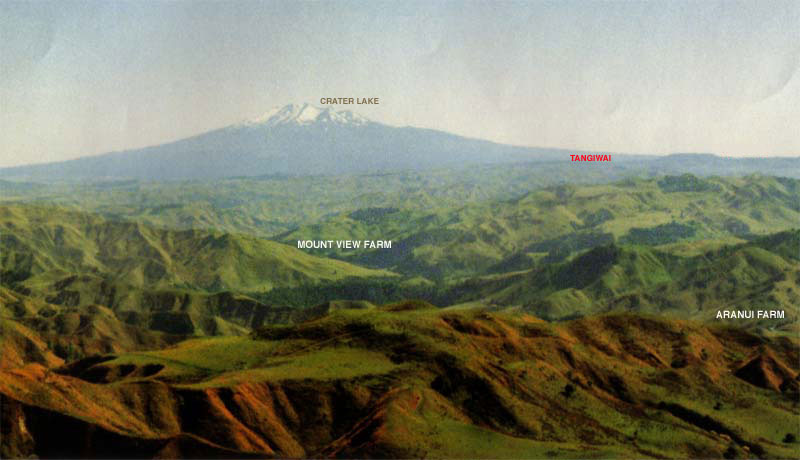 Photo: Karen Harris Mangamahu after the Tangiwai disasterOn Christmas Eve 1953, a lahar from Mt Ruapehu came rushing down the Whangaehu river and swept away the Tangiwai railway bridge, at 10.20 pm, just as the Limited Express was crossing it. The engine and the first six carriages went into torrent, at about the very moment as my parents were filling our pillow cases with Christmas presents, 60km downstream. We woke up mum and dad just before 6-o-clock on Christmas morning to show them what Father Christmas had brought us. And dad turned on his bedside radio to see how many runs Australia had scored overnight in their Test against England for the Ashes. Instead, he heard the announcement "A passenger train has been swept away in a flood at Sulphur Creek." He and mum left us to our toys and went out and across the road to the cliff above the river. When they got there they could hear a roaring noise up river and coming closer. Then a huge wall of liquid mud, 10 feet high, swept into view. When
I joined them a few minutes later, I was struck by all the
pillows being swept down by the torrent. Passengers on the
Limited Express used to pay two shillings to hire a pillow,
kapok filled, with a freshly washed white pillowslip on it,
to make their overnight journey more comfortable. There were
dozens and dozens of these white pillows floating past. But
my dad had noticed that some of the 'pillows' were
the naked backs of dead passengers . . . 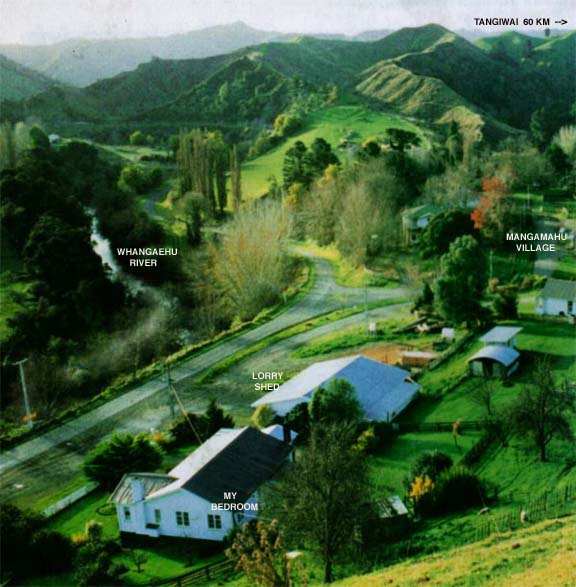
Every day my father had to
bring the bodies to his lorry shed, right beside our
dining room. There my mother and other Mangamahu
ladies cleaned them of mud and maggots and laid them
out decently.
Photo: Karen Harris
In March 2001, I was talking to an old Mangamahu farmer, Geof Addenbrooke, who was involved in recovering the bodies which were washed 150 kilometres down the Whangaehu river and into the papa gorges at Mangamahu. The old police constable who came out from Wanganui that Christmas morning put away his police notebook and went back into town again after after seeing how far down the bluffs were the first half-dozen bodies."Just bring them up yourselves, and then bring them to us in town." So
it was left solely to the young farming men of Mangamahu, in
the busiest month of their farming season, to recover the
bodies during that first week. Geof
Morris, who had fought in the Solomons, had seen many
mutilated dead bodies there, and was so traumatised that
he to go home by lunch time Christmas Day.
Without any of the army's rubber gloves. body bags, stretchers, winches on recovery vehicles or ambulances, the others just soldiered on with just their bare hands, strong backs, courage, comradeship and commitment forged in the fires of WW2. Apart from four good keen men from the Tararua Tramping Club, who turned up to help within 24 hour, the only other outsiders were civilians who came for the big sweep on New Year's Day. Near Aranui, a couple of farm-workers swam down a long stretch of river, searching for bodies caught up in the trees. At Harris's, a couple of boys scrambled and slid down crumbling 100-foot papa bluffs, grabbing at dangling roots of kowhai trees to get to the bodies. They carried horribly mangled bodies up out of the river trench, often by swimming down into a gorge, climbing 15 feet up a willow tree to cut a dangling body out of its branches, and then many of the near-naked bodies, man-handling them straight up the papa bluffs, slung across their backs.
Many
of the bodies the men recovered were of young women,
because the first carriage to be swept into the river
and into the fastest current was almost full of young
Bible School teachers going to Auckland for a Christmas
to New Year training course. Local women who assisted in
cleaning the bodies and making them decent later spoke
of "All the naked girls."
After carrying each girl to the farm
gate the young farm worker then had to return to catch up
with his work-day, leaving her lying alone by the roadside,
covered only by his black singlet, until my father could
make his daily collection trip. Geof Addenbrooke said his
wife had to burn several sets of his stinking,
maggot-infested clothing. "One of then I recovered,"
recalled Geof Addenbrooke, "Had only her roll-up girdle
still on her." Local farmer John Polson had been a fighter pilot and then a flying instructor at Ohakea during WW2, and after about 10 days he obtained a liferaft from the air-base there. John then took young Garry Harris with him looking for the Tangiwai victims who had been initially buried in the mud, and had then floated to the surface as their bodies swelled.
I was a 12-year-old at the time, living in the middle of the
Mangamahu village. My dad was the local carrier.
In the middle of each day, my dad would collect the "bods,"
as they were referred to, lie them on the back of his truck
and bring them to our lorry-shed, right beside our house.
Over the weeks of those strange school summer holidays, dad
had to store 40 bods in our shed. My mum and a couple of
other ladies would wash the mud and blood and maggots off
them and cover their bodies decently. My
mum's guiding principle was 'What would people think?'
Every
evening,
Des Fromont, another good Catholic carrier, would
come out from Wanganui and take the day's collection into
town on the back of his road-metal truck with raised sides,
with a tarpaulin covering the truck's deck.
In Wanganui, the washed and decently laid out bodies were
handed over the the police there.
The police never supplied any of the rescuers with
protective clothing, and Des got blood poisoning from having
to handle the bodies with his bare hands, The searchers at Mangamahu generally found victims whose bodies were mostly intact, and consequently who would float. But they also reported that they often saw viscera hooked up on the willow branches, an indication that many victims had been ripped open, and consequently remained buried in the mud. Some were also found with arms, legs, or even their heads missing.
All that stuff you read in books about the Tangiwai disaster, about all the resources of the army, navy, public works department, NZ railways and police being used for the next three days to recover bodies downriver from the wrecked train, all that was nothing compared to what the Mangamahu people did all by themselves further down the river, for weeks on end, and which never got reported. Those Mangamahu people were heroes. John Archer Contact me about how the Tangiwai disaster affected you. Mangamahu School May 2001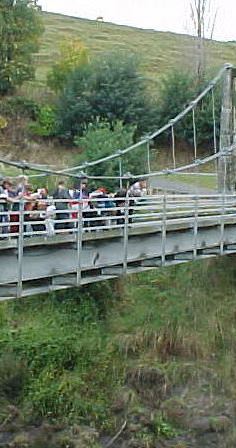 Thirty Mangamahu children cross the Whangaehu
river on a swing-bridge to get to school each day. I went
to the Mangamahu School in May 2001 and we talked about
the Tangiwai disaster. The children had all brought
bunches of flowers to school. After I talked to them, they
all made little memorial paper "life-rafts" or
"love-boats" which they decorated with flowers and hearts
and messages of sympathy like
Thirty Mangamahu children cross the Whangaehu
river on a swing-bridge to get to school each day. I went
to the Mangamahu School in May 2001 and we talked about
the Tangiwai disaster. The children had all brought
bunches of flowers to school. After I talked to them, they
all made little memorial paper "life-rafts" or
"love-boats" which they decorated with flowers and hearts
and messages of sympathy like
We will leave the people who are beured in the silt. We will let you rest in peace"
|
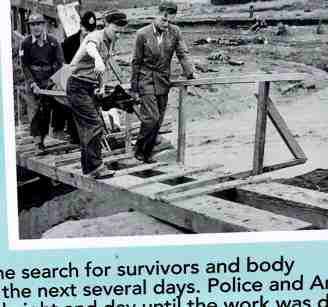
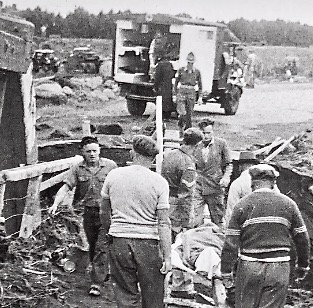
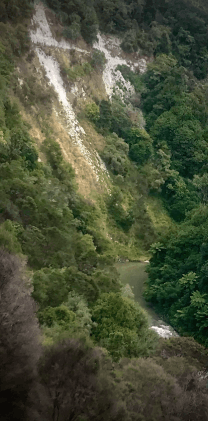
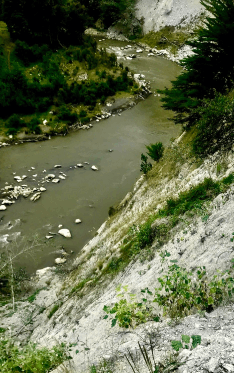
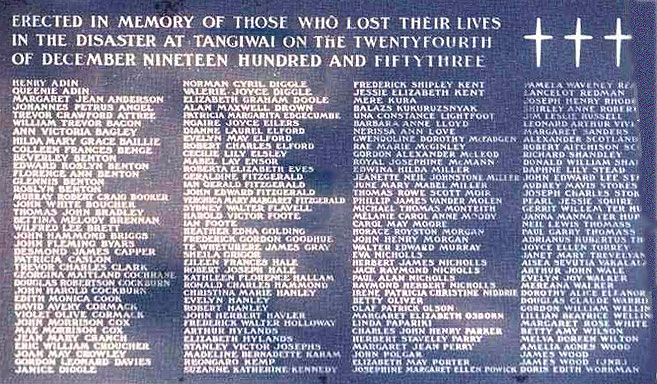
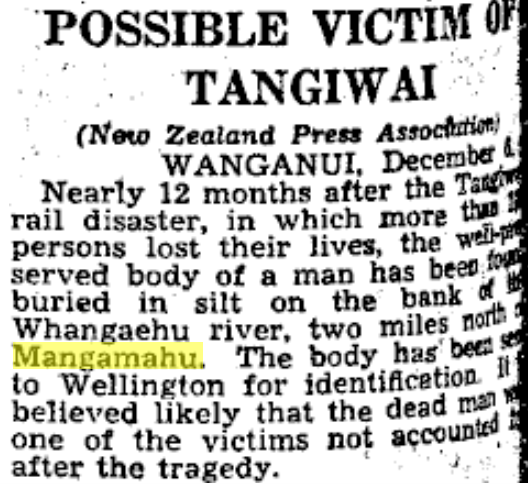 Almost
a year after the train disaster, Geof Morris found a
mummified body in the eroding silt at the river edge,
and he informed
the police. Then possibly to compensate
for their absence a year earlier, they came out en masse and
did a big "possible murder" investigation, making a huge
fuss, with Geof as their prime suspect.
Almost
a year after the train disaster, Geof Morris found a
mummified body in the eroding silt at the river edge,
and he informed
the police. Then possibly to compensate
for their absence a year earlier, they came out en masse and
did a big "possible murder" investigation, making a huge
fuss, with Geof as their prime suspect.